Exploring Alcohol Spray: Uses, Effectiveness, and Safety
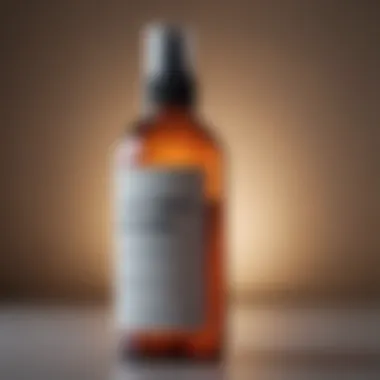
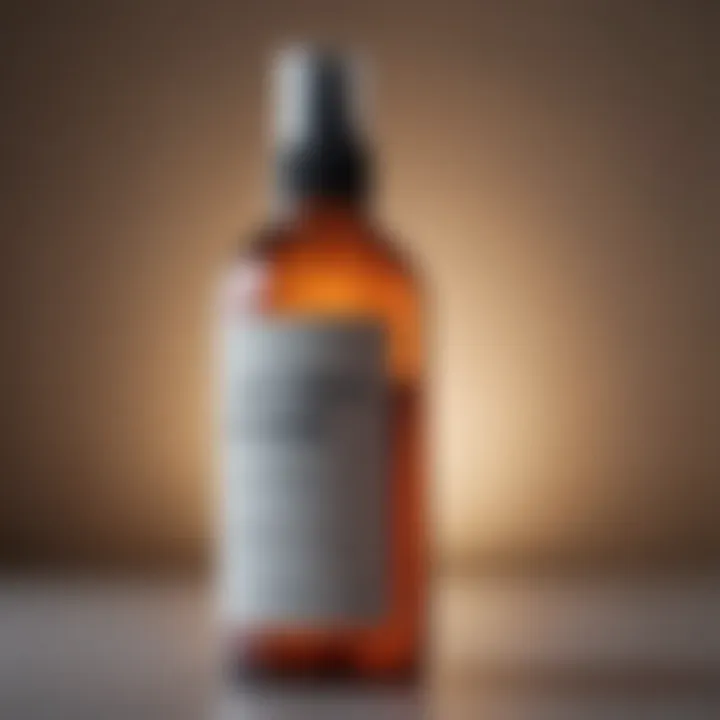
Intro
In recent times, alcohol sprays have carved out a noteworthy niche in both personal care and sanitation realms. Their often brisk application, combined with an impressive ability to remove viruses and bacteria, makes them a staple in many households and professional settings alike. Yet, few people pause to delve deeper into the workings of these versatile solutions. Understanding the science behind alcohol sprays, alongside their practical uses and safety concerns, can help to better appreciate their role in our daily lives.
The applications of alcohol sprays extend far beyond simply disinfecting surfaces. They evolve to include personal hygiene, skincare, and even first aid. This range means that both consumers and industry professionals must grasp the varying effectiveness, benefits, and potential hazards associated with the misuse of alcohol formulations.
Moreover, with a robust market demand fueled by heightened health consciousness, navigating the intricacies of alcohol sprays in terms of efficacy and potential risk becomes more pressing. Amidst changing regulations and evolving public perceptions, comprehending the full spectrum of alcohol sprays is not just beneficial—it’s essential.
Preface to Alcohol Spray
Understanding alcohol spray is essential in today’s world, especially in the current climate where hygiene plays a crucial role in public health. Alcohol sprays are widely recognized for their sanitization capabilities and have found their way into numerous applications. From personal care products to industrial cleaning solutions, their versatility cannot be understated. The function of these sprays goes beyond mere cleanliness—they offer an effective means to combat harmful microorganisms, making them significant in various sectors. Therefore, studying the alcohol spray landscape offers critical insights into its efficacy, safety, and usage considerations.
Definition and Composition
Alcohol sprays are typically solutions comprising various alcohols, mainly isopropyl alcohol or ethanol, diluted with water and sometimes other additives to enhance their efficacy or scent. These combined ingredients yield a solution effective in killing bacteria and viruses on surfaces and skin. The concentration of alcohol usually ranges between 60% to 90%, critical to ensuring the product's effectiveness. Higher concentrations tend to work quicker and are often favored in medical settings.
- Isopropyl Alcohol: Commonly used in medical and personal care settings.
- Ethanol: Mostly found in hand sanitizers and disinfecting wipes.
- Additives: These can include agents that improve skin feel or fragrances, although pure formulations tend to be favored in clinical environments.
The composition of alcohol sprays makes them suitable for disinfection and serves various applications while maintaining safety standards.
Historical Context
The advent of alcohol as a disinfectant dates back centuries. Historically, alcohol was isolated from natural sources during fermentation processes long before its antimicrobial properties were understood. The real turning point came in the 19th century when scientists began advocating for the use of alcohol in medical sanitation.
By the late 1800s, using alcohol for sterilization gained traction in hospitals as a means to combat infections and diseases. The effectiveness of alcohol as a disinfectant became even more crucial during times of war when battlefield conditions necessitated quick and efficient sanitation methods.
- 19th Century: Adoption in medical practices spurred advances in public health.
- 20th Century: The development of commercial alcohol sprays brought effective disinfectants into homes and businesses.
Thus, the historical significance of alcohol spray not only emphasizes its role in maintaining hygiene but also highlights how innovation has harnessed its chemistry to meet modern needs.
Chemical Properties of Alcohol
Understanding the chemical properties of alcohol is crucial in comprehending the various applications and effectiveness of alcohol spray. Alcohols are organic compounds characterized by the presence of one or more hydroxyl (-OH) groups attached to a carbon atom. The unique structure of alcohols contributes to their functional versatility, affecting everything from their solubility and volatility to their reactivity. This section explores how these properties shape the use of alcohol sprays, particularly in disinfection and personal care.
Structure and Functionality
The structural makeup of alcohol is essential for its functionality. Alcohols can be classified primarily as primary, secondary, or tertiary, depending on the position of the hydroxyl group. For instance, ethanol, a primary alcohol, has the hydroxyl group located at the end of its carbon chain, while isopropyl alcohol is a secondary alcohol with more complex branching.
These structural differences influence the physical properties of alcohols significantly. For example:
- Boiling Point: The boiling points of alcohols increase with the length of the carbon chain and hydrogen bonding capacity. This property is vital when considering how to store or apply alcohol sprays.
- Solubility: Alcohols are often less volatile and more soluble in water compared to other organic compounds, which makes them effective for application in various solutions. The polar nature allows for great cleaning action and penetration into surfaces or biological materials.
Such properties underscore why alcohols are favored in sanitization and personal care products. Moreover, their ability to act as a solvent widens their applicability in various industries, making them indispensable.
Types of Alcohols Used in Sprays
Different types of alcohols are utilized in sprays, each bringing its unique benefits to the table. Here’s an overview of some alcohols commonly found in these products:
- Ethanol: Often recognized as drinking alcohol, ethanol is a popular choice for disinfectant sprays. It’s highly effective against a wide range of pathogens, including bacteria and viruses, when used at concentrations of 60% to 90%.
- Isopropyl Alcohol: Commonly known as rubbing alcohol, isopropanol is another go-to for cleaning and disinfecting. It evaporates quickly and leaves no residue, making it ideal for use on electronics and other sensitive materials.
- Methanol: While highly effective as a solvent, methanol is not safe for personal use; hence, it’s more reserved for industrial applications. Its inclusion in sprays can pose health risks, and it's crucial that manufacturers adhere to guidelines restricting its use in consumer-facing products.
In sum, the choice of alcohol type directly impacts the efficacy and safety of the spray. Selecting the appropriate alcohol and understanding how its structure influences its properties can enhance practical applications across various sectors.


"Alcohol, in its various forms, is an invaluable player in the field of hygiene and sanitation, illuminating the balance between efficacy and safety in everyday products."
Recognizing the chemical disposition of these compounds helps in grasping their behavior and performance in real-world applications. This knowledge is indispensable for industries seeking to leverage the capabilities of alcohol spray effectively.
Applications of Alcohol Spray
The applications of alcohol spray cannot be overstated owing to their multifaceted uses across a range of settings. These handy sprayers are employed in daily lives for sanitation, personal care, and various industrial processes. Knowing how alcohol sprays function and where they're applicable can empower users and consumers to harness their effectiveness, underscoring the significance of proper application methods. This realm is not just about convenience; it also touches on public health, environmental issues, and innovation in product development.
Sanitation and Disinfection
Alcohol spray plays a pivotal role in sanitation and disinfection, particularly in today’s health-conscious society. In both households and healthcare settings, alcohol-based solutions are a go-to for killing germs and preventing the spread of infectious diseases. Many studies highlight that alcohol can effectively eliminate a variety of pathogens, including bacteria and viruses. For instance, isopropyl alcohol, often found in many standard disinfectants, can disinfect surfaces swiftly and thoroughly.
- Speed and Efficiency: The quick-drying nature of alcohol allows it to evaporate rapidly after application, leaving surfaces clean and free of pathogens. This is particularly beneficial in busy environments like hospitals, where time is of the essence.
- Versatility: Alcohol sprays can be used on various surfaces, from countertops to medical instruments, making them extremely versatile. Some facilities even employ these sprays for electronic equipment, given that they dry fast without leaving moisture behind that might damage sensitive components.
However, there’s a balancing act here. It’s crucial to ensure that surfaces are properly pre-cleaned before applying alcohol sprays, as debris can hinder the efficacy of the disinfection process.
"Proper sanitization doesn't just happen; it's a practiced art that utilizes the right tools at the right time."
Personal Care and Hygiene Products
The integration of alcohol sprays into personal care routines is increasingly common, particularly as people become more conscious about personal hygiene. Alcohol-based hand sanitizers, for instance, have become indispensable in hand hygiene practices.
- Convenience: They are portable, making them perfect for on-the-go sanitation, especially in public spaces where soap and water might not be readily available.
- Formulation Innovations: Brands are now combining alcohol with moisturizing agents to address dryness that can accompany frequent use, which highlights the industry's response to consumer needs.
Additionally, alcohol sprays are found in products like facial mists and body sprays, often promoting antibacterial properties, appealing to those who wish to maintain not only cleanliness but also a fresh feeling throughout their day. Wasn’t that a smart move in product development?
Industrial Uses
Within industrial sectors, alcohol spray is an unsung hero, often facilitating processes that might not generally come to mind. For example, workers in graphic design and printing might use alcohol to clean print heads or tools, ensuring smooth operations without the risk of contamination.
- Cleaning Equipment: In manufacturing, alcohol-based sprays are employed to clean machinery and equipment, thereby maintaining performance and extending the lifespan of the tools used.
- Food Industry Applications: In food processing, alcohol sprays ensure sanitized surfaces and tools, contributing to overall food safety, especially in environments prone to contamination.
In summary, the diverse applications of alcohol sprays touch on critical aspects of daily life and various industries. From effective disinfection practices to innovations in personal hygiene and industrial cleanliness, the implications are far-reaching and worth understanding. As the conversation surrounding alcohol usage continues to evolve, being informed can help users make better choices for personal and public health.
Efficacy of Alcohol Spray
In the realm of sanitation and personal care, the efficacy of alcohol spray holds significant weight. Understanding how effective these sprays are is crucial for both consumers and professionals alike. With growing concerns about hygiene and the spread of pathogens, knowing the ins and outs of alcohol spray efficacy provides reassurance. It's not just about having a bottle of sanitizer at hand; it's about understanding what makes it work.
The effectiveness of alcohol sprays can be attributed to their ability to disrupt the cellular structure of bacteria and viruses. This can lead to a reduction in microbial load on surfaces and skin, making them a go-to option for many applications, from daily hygiene to industrial use.
Antimicrobial Properties
Alcohols like ethanol and isopropyl alcohol are celebrated for their antimicrobial properties. When applied, these substances have a remarkable ability to penetrate the lipid membranes of microorganisms. This penetration compromises the structural integrity of the microbes, effectively leading to their death. In a study published in a reputable microbiology journal, it was found that 70% ethanol yields the best results in killing a wide range of pathogens while minimizing skin irritation.
"Alcohol-based solutions are known to be effective against a wide variety of bacteria, fungi, and viruses, making them essential in infection control."
Moreover, the antimicrobial action of alcohol is rapid—not something that takes ages to kick in. Within seconds of application, alcohol can begin to eliminate harmful pathogens. This immediate action is pivotal in situations where time is of the essence, like in healthcare settings.
Effectiveness against Viruses and Bacteria
When it comes to effectiveness against viruses and bacteria, alcohol sprays have proven to be quite formidable. For instance, the Centers for Disease Control and Prevention (CDC) recommends alcohol-based hand sanitizers containing at least 60% alcohol by volume for effective disinfection. This recommendation isn’t just any run-of-the-mill advice—it's grounded in empirical studies showing that alcohol sprays can significantly reduce viral titers on surfaces.
Recent investigations have indicated that alcohol is particularly effective against enveloped viruses, such as influenza and coronaviruses, owing to their lipid nature. However, it's worth noting that while alcohol sprays are effective, they may not work universally against all microorganisms. Unencapsulated viruses or certain resistant bacterial strains may require more aggressive or different disinfecting agents.
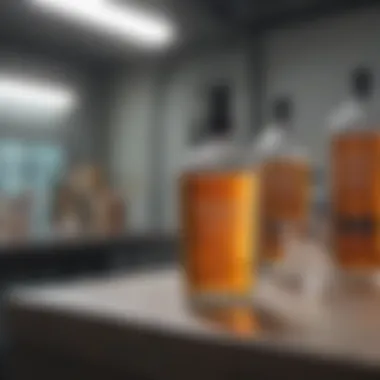
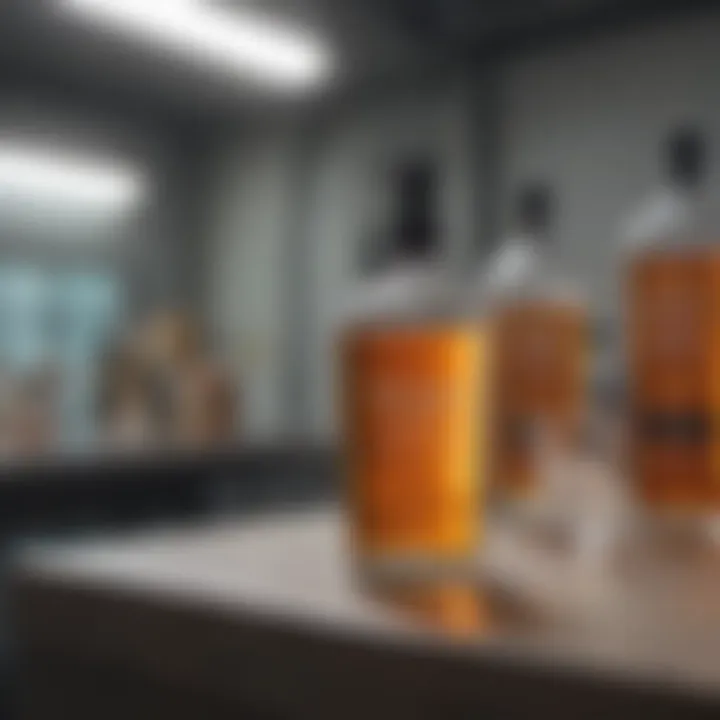
In summary, the efficacy of alcohol spray is underscored by its rapid action, range of effectiveness against various pathogens, and its integral role in sanitation practices. Knowing the strengths and limitations of these sprays offers valuable insights for consumers and professionals, paving the way for informed decisions in maintaining hygiene.
Safety Considerations
When diving into the realm of alcohol sprays, the significance of safety considerations cannot be overstated. These products, while beneficial in various scenarios such as disinfection and personal care, carry their own set of risks that users must navigate carefully. Understanding the safety protocols not only ensures a smoother experience for the user but also mitigates potential hazards inherent in the use of these substances.
Health Risks and Precautions
Health risks associated with alcohol sprays arise primarily due to the nature of the chemicals involved.
- Flammability: One of the prominent risks is the flammable nature of alcohol. When spaying, it is essential to avoid open flames and sparks, which can lead to disastrous fires.
- Respiratory Issues: Prolonged inhalation of alcohol vapors can irritate the respiratory tract. It’s advisable to use these sprays in well-ventilated areas, and ideally not too close to the face.
"While alcohol sprays can be effective in combating germs, their safety largely depends on the caution observed during use."
- Skin Reactions: Some individuals may develop skin reactions or allergies when using alcohol-based products. Testing a small patch of skin before full application is often recommended, especially for those with sensitive skin.
- Disposal Concerns: Improper disposal of alcohol containers can lead to accidents. Follow local regulations for disposal to avoid environmental contamination.
By adhering to a few simple precautions, such as ensuring proper ventilation, storing alcohol sprays away from heat sources, and checking skin sensitivity, users can substantially reduce the risks associated with these products.
Environmental Concerns
When considering the safety of alcohol sprays, one must also take into account their environmental impact. Although these products are often essential for hygiene, they come with potential downsides that warrant attention.
- Volatile Organic Compounds (VOCs): Many alcohol sprays release VOCs into the atmosphere, contributing to air pollution. This is particularly concerning in confined spaces where ventilation might be limited.
- Water Pollution: When these products are washed off surfaces, they can enter the water systems. This pose risks to aquatic life and can disturb local ecosystems. Therefore, using alcohol responsibly and sparingly is vital.
- Recycling and Waste: The packaging of alcohol sprays, often made of plastic or aerosols, adds to the global waste problem. Users should consider choosing brands that prioritize eco-friendly packaging or that offer refillable containers.
An approach focused on sustainability — such as using alcohol sprays only when necessary, selecting products with lower environmental impact, and recycling packaging — can help balance the practical benefits of alcohol sprays with an awareness of their environmental footprint.
Regulatory Framework
Understanding the regulatory framework surrounding alcohol sprays is crucial as it directly impacts their safety, efficacy, and overall public acceptance. Regulations ensure that these products are not only effective in their intended uses, such as sanitization and personal care, but also safe for users and the environment. These guidelines help in promoting proper practices in production and usage while informing consumers about what they are using on their bodies and in their spaces.
Key Elements of Regulatory Framework
- Standards for Production: Regulations set standards for the composition and quality of alcohol sprays, ensuring that manufacturers adhere to scientific principles. This means they must use safe concentrations of alcohol, select appropriate additives, and follow good manufacturing practices to prevent contamination.
- Safety Testing: Regular safety evaluations are mandated, including testing for skin irritation, toxicity, and other potential side effects of usage. These evaluations are essential for identifying any adverse reactions before products reach the consumer.
- Consumer Protection: Rules protect consumers from misleading claims, ensuring manufacturers cannot exaggerate the effectiveness of their products. Clear standards help consumers make informed choices.
Having a firm regulatory framework strengthens trust in the product among consumers and professionals alike. Without it, the risk of subpar products entering the market could increase, undermining public health efforts.
Guidelines for Production and Use
Regulatory bodies typically provide detailed guidelines for the production and use of alcohol sprays. These guidelines serve several important purposes for both manufacturers and consumers.
- Quality Control Measures: Established protocols guide manufacturers in maintaining high standards throughout the production process. This includes regular audits and tests to verify quality and safety.
- Permissible Ingredients: Only specific alcohol types, such as ethanol or isopropanol, are permissible due to their proven efficacy. Guidelines specify not only these substances but also other chemicals that can be included safely in formulations.
- Usage Instructions: Directions for use help consumers maximize both efficacy and safety. For example, sprays designated for surface sanitation often have instructions that specify which surfaces are suitable and how long they need to remain wet for maximum effect.
Furthermore, adherence to these guidelines is usually monitored through legal frameworks that sanction non-compliance and protect consumer interests.
Labeling and Consumer Information
Labeling and consumer information play indispensable roles in the appropriate use and understanding of alcohol sprays. They encompass all details a consumer needs to be aware of when using these products.
- Ingredient Disclosure: Labels must list all ingredients transparently. This helps those with allergies or sensitivities to specific substances to avoid adverse reactions. For instance, a consumer allergic to certain fragrances will be aware and can steer clear, hence reducing health risks.
- Dosage Instructions: Clear dosage and application methods outlined on the label ensure users know how much to spray and when. For example, some products may advise applying on a surface and allowing it to stay for at least 30 seconds for disinfection.
- Warnings and Precautions: Notices regarding potential risks or situations when to avoid using the spray are critical. These can range from keeping the product away from flames because of flammability to ensuring good ventilation during use.
"Transparency in labeling not only safeguards public health but also fosters trust between consumers and manufacturers."
Public Perception and Acceptance
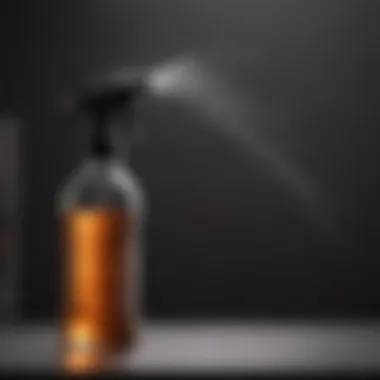

The public's perception of alcohol spray is pivotal in shaping its usage and acceptance in various settings. Understanding this perspective offers insights not just into consumer choices but also illuminates broader societal trends and health habits. In a world where sanitization has become vital, especially following the previous pandemic years, alcohol sprays have taken center stage. They are no longer seen merely as medical supplies but have crept into daily life as staples in personal care and hygiene routines.
This section explores specific elements that influence public perception, including trends in consumer behavior and the prevalence of misinformation in society. Both elements significantly affect how individuals and institutions adopt these products, leading to a nuanced understanding of alcool sprays in contemporary culture.
Trends in Consumer Behavior
Modern consumers have become increasingly health-conscious, and their behaviors reflect a shift toward products that promote safety and cleanliness. The rise in demand for alcohol spray can be attributed to several trends:
- Increased Awareness: The COVID-19 pandemic catalyzed a wave of awareness around sanitization methods. Many consumers have made alcohol sprays a fixture in their households, using them not just for personal hygiene but also for cleaning surfaces.
- Sustainability Concerns: As consumers become more eco-minded, brands that offer environmentally friendly alcohol sprays tend to attract a loyal customer base. Products with sustainable sourcing and minimal environmental impact are more likely to be accepted.
- Convenience and Accessibility: Alcohol sprays offer a high level of convenience. The ease of use appeals to busy lifestyles where many individuals seek quick and effective solutions for cleanliness.
"Consumer behavior is not just about what you buy; it reflects your values and beliefs."
Misinformation and Awareness
Misinformation surrounding alcohol sprays can confuse consumers, leading to either overuse or inadequate use of these products. Areas where misunderstanding flourishes include:
- Effectiveness Claims: Many individuals are exposed to conflicting claims about the antimicrobial properties of various alcohol concentrations. Some believe that higher concentrations are always better, when in fact, a 60-70% concentration is often most effective for disinfection.
- Health Risks: There's a misconception that alcohol sprays are entirely safe due to their common usage, which can lead to neglect of safety precautions. Often, people underestimate the importance of ventilation when using alcohol-based products in enclosed spaces.
- Misinterpretation of Regulations: Consumers may not fully grasp the guidelines that govern what constitutes a safe and effective product. Clarity around labeling and usage instructions can help eliminate confusion.
The importance of proper information dissemination cannot be overstated. Accurate communication from brands, combined with reliable sources, can aid in better consumer education, leading to safer practices and a constructive public attitude towards alcohol sprays.
Future Directions
Understanding the future directions of alcohol spray technology is actually unearthing a treasure trove of possibilities that could influence various sectors in surprising ways. With advancements in formulation science and growing awareness of hygiene, the importance of this topic is hard to overstate. As the field evolves, we see that the innovations not only promise improvements in efficacy but also cater to more nuanced consumer needs. A clear grasp of what may come next can guide both manufacturers and end-users alike, ensuring that alcohol sprays are used effectively and safely.
Innovations in Formulations
Recent years have witnessed an upsurge in the development of innovative formulations of alcohol sprays. Manufacturers are now focusing on creating solutions that are more effective yet gentler on the skin. Ingredients are now paired with alcohol to enhance skin compatibility. For instance, aloe vera and vitamin E are becoming more common, contributing to a dual benefit: sanitization and skin care.
In addition, the industry is exploring sustainable options by incorporating bio-based alcohols derived from natural fermentation processes. This pivot to sustainability not only helps to mitigate environmental impact but also aligns with the values of eco-conscious consumers.
Furthermore, carriers that facilitate longer-lasting effectiveness are currently in research. These could revolutionize the way we use alcohol sprays by providing extended protection compared to current options. The goal is to create formulations that not only eliminate germs but do so in a manner that's friendly to both the skin and the environment.
Potential New Applications
The potential applications of alcohol sprays extend far beyond mere sanitation. One exciting frontier is in the realm of healthcare. Hospitals could utilize specialized alcohol sprays for not just disinfecting surfaces, but also for administering patient care through innovative delivery systems. For example, sprays developed with controlled release properties could be used for quick disinfecting without requiring extensive downtime between patients.
Retail sectors are also looking at innovative applications. Imagine alcohol sprays that are infused with scents while still maintaining their antimicrobial properties, making them attractive for personal use but also as an enticing upsell for consumers in stores.
Not to forget, the realm of travel has birthed a niche for personalized alcohol sprays that cater to specific needs, from public transportation to crowded events. These could be easy-to-carry solutions that promise protection without compromising convenience. This adaptability makes alcohol sprays integral to modern-day hygiene practices.
"The future of alcohol sprays holds the potential for advancements that could redefine personal and public health hygiene standards."
The End
In the final analysis of alcohol spray, its importance becomes crystal clear. The multifaceted uses of alcohol sprays in disinfection, personal care, and industrial settings, interwoven with safety and efficacy, shape the very essence of why this topic warrants attention. The culmination of findings throughout this article elucidates the vital role that alcohol sprays play in contemporary practices, impacting both individuals and industries alike.
Summary of Findings
Throughout the discourse, we’ve unearthed critical insights about alcohol sprays. Here’s a snapshot of key points:
- Efficacy in Disinfection: Alcohol sprays demonstrate reliable antimicrobial properties, making them effective in killing a broad spectrum of pathogens, including viruses and bacteria. This capability is crucial, especially in health-conscious settings like hospitals.
- Personal Care Utilization: Beyond sanitation, alcohol sprays find their place in personal hygiene products. Users can benefit from the convenience of an on-the-go sanitation method that adapts to busy lifestyles.
- Safety and Regulation: The article highlighted not just the advantages of alcohol sprays, but also the attendant risks and the importance of regulatory frameworks. Awareness of proper usage guidelines helps mitigate health risks—the cornerstone of responsible consumption.
Implications for Users and Industry
The implications of alcohol sprays ripple across various sectors. For users, understanding how to effectively utilize alcohol sprays can enhance personal hygiene practices, especially when there’s little access to soap and water. In an industry context, businesses that harness alcohol sprays in their operations are likely to meet both compliance requirements and consumer expectations. Key implications include:
- Enhanced Health Awareness: Users are becoming increasingly aware of sanitization practices, shaping demand for effective products. This trend signifies a shift in consumer expectations towards cleanliness and safety in both personal and public spaces.
- Innovation Opportunities: The market for alcohol sprays is ripe for innovation. Manufacturers can explore new formulations and delivery methods, marrying convenience with efficacy. As consumers seek effective solutions, the industry can capitalize on developing sustainable and effective products.
- Regulatory Landscape: With the rise in demand for alcohol sprays, staying abreast of regulatory changes becomes vital for manufacturers. Compliance with guidelines not only safeguards consumer health but also fortifies brand reputation.
Ultimately, the sustained relevance and potential of alcohol sprays hinge on their adaptability and responsiveness, presenting vast opportunities for users and industries alike.







